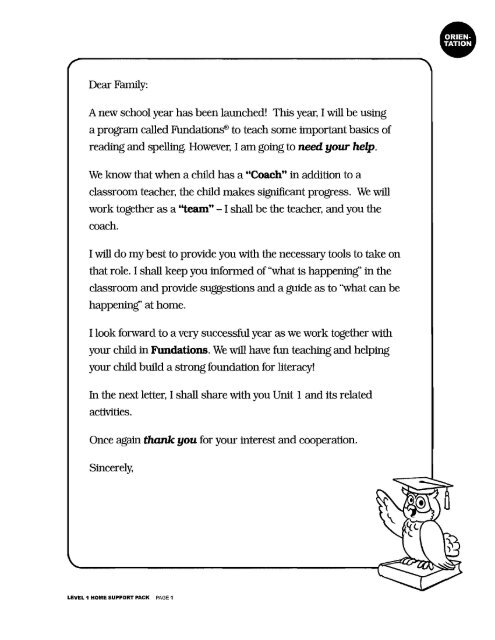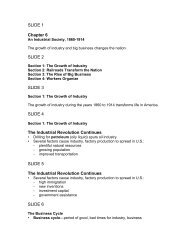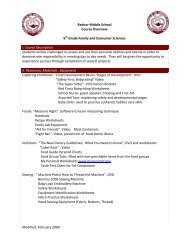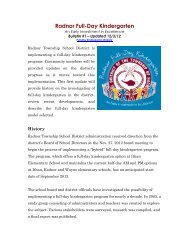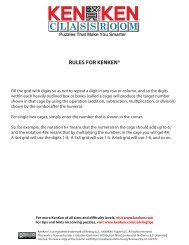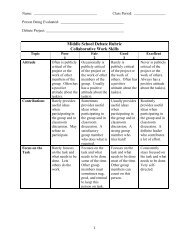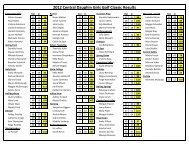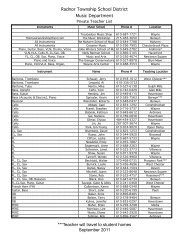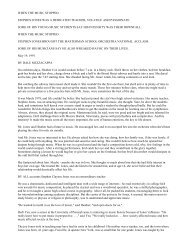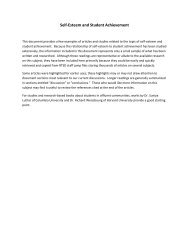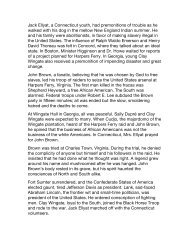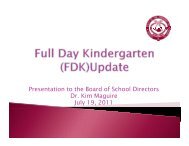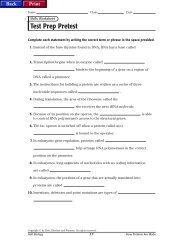FUNdations- Level 1 Support Pack
FUNdations- Level 1 Support Pack
FUNdations- Level 1 Support Pack
- No tags were found...
Create successful ePaper yourself
Turn your PDF publications into a flip-book with our unique Google optimized e-Paper software.
You are likely wondering, "What is Fundations®?"Research indicates that systematic and explicit phonics instruction is effective for allchildren. FUndations provides a systematic and explicit approach to reading and spellingwith phonics. We will combine this instruction with the reading of good literature,wbich is just as important for your child's development.Fundations is systematicbecause it follows a very defInitesequence for teaching and it follows avery defInite procedure to teach thoseconcepts.Fundations is explicitbecause this program does not leaveroom for guessing. It teaches all conceptsdirectly. The children will review lettersand how to form these letters. They willlearn sounds using keywords to helpthem remember. They will soon move onto blend the sounds into words.You are also probably wondering,"How can I become a successful"Coach" in this reading program?"As a "Coach" you can:1. Read the FUndations letters that Isend home. These letters will containup-dates, program information, andactivity suggestions.2. Set aside time to do the "homeactivities" with your child.3. Monitor your child's progress andshare successes as well as concernswith me.As the year progresses, FUndationsintroduces many aspects of wordstructure and sentence structure. I shallbe sending home guides and activities forall of this.I feel certain that you will fInd working with your child in FUndations very rewarding.Your child will treasure your involvement!LEVEL 1 HOME SUPPORT PACK PAGE 2 ©2002 Wilson Language Training Corporation Wilson Fundations'"
fI) .'Help Develop Oral Expression And VocabularyYou can help your child develop orallanguage (the spoken word) with thefollowing ideas. Do these anytime you arewith your child:1. Encourage your child to answer''wonder'' statements.Say such things as "I wonder whya dog barks." Or say, "I wonder ifGrandpa likes spinach."2. Help your child expand hislhervocabulary by rephrasing.4. Limit the amount of TVHowever, if your child watches achildren's program, talk about it(see #'s 1, 2, 3).5. Provide household props thatencourage pretend play.Use spoons/pans in the bathtub;cups/teapots/dolls; small rakes/shovels. While playing, be sure to talkthrough your actions (see #'s 1, 2,3).When your child says somethingsuch as, "He's scared," you couldsay, "Yes, the dog barks because he isfrightened, you are correct!"3. Ask open-ended questions.Do not ask, "Are you raking leaves?"(The child would simply answer,"yes.") Instead, ask, "What are youdOing with your rake?" The childwill answer you and then you canrephrase the answer to furtherdevelop vocabulary (see # 2).Verbally interacting with your child simply means taking every opportunity to talkwith your child. With our busy lives, interactions between adults and children areoften directive ("do this," "do that,") or negative ("stop hitiing," "don't run.") Try tobreak this pattern whenever possible. Both you and the child will have pleasantexperiences and you will be helping to develop oral expression and vocabulary,LEVEL 1 HOME SUPPORT PACK PAGE 3 ©2002 Wilson Language Training Corporation Wilson Fundations'"
oDear Runily:We are now ready for you to be your child's Coach. If your childhad FUndations® in Kindergarten, Unit 1 is mostly review and willgo quickly. If your child did not have FUndations in Kindergarten,do not become discouraged with the pace of the progress. It mayappear to be slow moving. but it is laying the necessary foundationsfor your child to be a fluent, independent reader.During the next few weeks, I will be reviewing:• The sequence of the alphabet.• Letter formation from a to z .• The letter name and a keyword for the consonants:bcdfghjklmnpqrstvwxyz• The letter name, and a keyword for the short vowels: a e i 0 UThe keyword is a specific word which we will use to help your childmaster each sound. Notice the letter y is not included as a vowel.This comes later. Ify begins a word it is considered a consonant andfor now, it will only begin words.Please work with your child to reinforce the above concepts. Seethe attached activi1y suggestions in order to do this. If you have anyquestions, please write them down and I shall get back to you.WEARE OFF!Sincerely,LEVEL 1 HOME SUPPORT PACK PAGE 1
RevIew the Sequence oJ the AlphabetYour child needs to be able to say or singthe alphabet from A to z. Sing or saythe alphabet whenever you can - in thecar, bath time, bedtime, etc.Make sure your child is aware of eachletter! So often "Imnop" is lumpedtogether and the child does not separatethem.If you have magnetized plastic letters,have your child place them on yourrefrigerator in sequence as he or she saysthe letter name.ABCDEFGHIJKLMNOPQRSTUVWXYZYou will find the suggested books listedbelow helpful at this time. They shouldbe available at your local library.FolloWing this page, you will find thealphabet order squares. Have your childlightly color the vowels (a e i 0 u) orange.Keep one of the groups of squares uncutto use as the base and cut the secondgroup into individual squares.Have your child place the letters onto thematching letters on the uncut squares.Make sure your child says the name ofthe letter as it is placed. Keep these lettersin a baggie to do this again and for otheractivities.If you enjoy crafts, you could make aplace mat and decorate it with one of theletter squares. Have your child place thecut letters on the place mat while waitingfor supper.TitleA-B-C ing. Action AlphabetThe Guinea Pig ABCAuthorBeller, J.Duke, KPUblisher I DateCrown; 1984Dutton; 1983Alphabears Hasue,K Henry Holt & Co.; 1984City Seen From A to Z Isadora, R. Greenwillow; 1983AUigators AU Around: An Alphabet Sendak, M. Harper Trophy; 1990Dr. Seuss's ABC's (2nd edition) Seuss, Dr. Random House; 1991Zoophabets Tallon, R. Scholastic; 1979The Z Was Zapped Van Allsburg, C. Houghton Mifflin; 1987LEVEL 1 HOME SUPPORT PACK PAGE 2 @2002Wilson language Training Corporation Wilson Fundations®
Review Letter Fbrmations With Your ChildFor the next three weeks, your child willpractice writing the letters in lower-case.Encourage correct pencil gripBe sure your child has the pencil betweenthe index finger and the thumb and thenrests it on the other fingers.Practice the letter formationsYou can practice the leiter formations athome just like we are practicing them inschool. See the attached writing paperwith pictures. We call this our WritingGrid. The pictures indicate the names ofthe lines: the sky line. plane line. grassline and worm line.Left Hand Pencil GripRight Hand Pencil GripWhen your child writes, both elbowsshould be on the table and feet should beon the floor, if possible. You can use anold box under the table if the table is toohigh. Also, have your child hold the paperwith the non-writing hand.Say the verbal step-by-stepguidelines while your child makeseach letter.As your child writes the letter, guide himor her by reading the directions on theenclosed Letter FOrmation Guide.Practice some letters each night, asindicated below. Have your child writeeach of these letters five times on theWriting Grid. Each time, be sure that youread the step-by-step directions to guidethe correct letter formation.LEVEL 1 HOME SUPPORT PACK PAGE 4©2002 Wilson Language Training Corporation Wilson Fundations®
fu?\WEEK 1 (Page 1 of 2) WFundations® Letter Formation-f --- --------- n_ - _n __ n __ n --- n n-6 n __ n_. - ------. - --.--- - ___n. ___ _-f-nu ___ ._ n _ ...__ n_.n. __ . .---.---::-n-------------------------------- ---:: ------------------------------------LEVEL 1 HOME SUPPORT PACK PAGE 5 ©2002 Wilson language Training Corporation Wilson Fundations®
Fundations® Letter Formationfu?\WEEK 1 (Page 2 of 2) W-.,... ----------------------------------- ------------------------1---------------------------------::-r-----------------------------------------------------------------------------------------------------------LEVEL 1 HOME SUPPORT PACK PAGE 6 ©2002 Wilson Language Training Corporation Wilson Fundations®
Fundations® Letter Formationfu?\WEEK 2 (Page 1 of 2) \.!J-0 ------ -- ----------------------- -- ....- ......... - .....•. - ...... - ............. - ........ - - ........ ... d -......... H- •••••• -- •••••••••••• - ••••••••••••••• -- ••••••••••••••• -- - -- - - - - - - - - - - - ---- - - -- - - - - - - - - - ---:: -p---------------------------------::-[)--------------------------------LEVEL 1 HOME SUPPORT PACK PAGE 7 ©2002 Wilson Language Training Corporation Wilson Fundations0
Fundations® Letter Formationfu?\WEEK 2 (Page 2 of 2) Wli-n _.. ____.__u_ . __ -______ nn ___ n_I( --.- H·_.- ._H ___ H _H H ---... H _. -. _.------------------------------------------------------------------------------------------"----------------LEVEL 1 HOME SUPPORT PACK PAGE 8 ©2002 Wilson Language Training Corporation Wilson Fundations0
Fundations® Letter Formationfu?\WEEK 3 (Page 1 of 2) W=e=.. .. .. ... ... ................................•....----------------------------------:: -y--------------------------------:: -W---------------------------------:: -7 ---- -------------------------------n---------------------------------LLEVEL 1 HOME SUPPORT PACK PAGE 9 ©2002 Wilson language Training Corporation Wilson Fundations0
Fundations® Letter Formation GuideUse the following verbalization to direct studentsin proper fetter formation.Letter Formation for Cc is a plane line round letter.Letter Formation for aIt starts on the (plane line).a is a plane line round letter.It starts on the (plane line).i. Point to the plane line.2. Start to fly backwardsi. Point to the plane line.2. Go back on the plane line then down andaround on the grass line,3. and up to the plane line.4. Trace back down to the grass line.:t and go down and around to the grass line.Letter Formation for dd is a plane line round letter.It starts on the (plane line) just like a c.Letter Formation for bb is a sky line letter.It starts on the (sky line).1. Point to the plane line.2. Go back, down and around to the grass line,3. all the way back up to the sky line.4. Trace back down to the grass line.1. Point to the sky line.2. Go down to the grass line.3. Trace up to the plane line,4. and around to the grass line.LEVEL 1 HOME SUPPORT PACK PAGE 11©2002 Wilson Language Training Corporation Wilson Fundations'"
Fundations® Letter Formation GuideUse the following verbalization to direct studentsin proper letter formation.Letter Formation for 9g is a plane line round letter.Letter Formation for eIt starts on the (plane line) just like a c.e is a plane line round letter, but it is special.e starts below the plane line.f1Il ,1. Point to the plane line.
Fundations® Letter Formation GuideUse the following verbalization to direct studentsin proper letter formation.Letter Formation for kk is a sky line letter.Letter Formation for ii is a plane line letter.It starts on the (plane line).It starts on the (sky line).i. Point to the sky line.2. Go all the way down to the grass line.3. Point to the plane line and leave a space.i. Point to the plane line.2. Go down to the grass line.4. Slide over and touch your taliline,S. and slide back to the grass line.3. Add a dot.Letter Formation for jj is a plane line letter.Letter Formation for II is a sky line letter.It starts on the (sky line).It starts on the (plane line).i . Point to the sky line.i. Point to the plane line.2. Go down to the grass line and stop.2. Go all the way down to the worm line, andmake a curve.3. Add a dot.LEVEL 1 HOME SUPPORT PACK PAGE 13©2002 Wilson Language Training Corporation Wilson Fundations®
Fundations® Letter Formation GuideUse the following verbalization to direct studentsin proper letter formation.Letter Formation for 0o is a plane line round letter.Letter Formation for mIt starts on the (plane line) just like a c.m is a plane line letter.It starts on the (plane line).j. Point to the plane line.2. Trace back, then down to the grass line,3. and around back up to the plane line.i. Point to the plane line.Z. Go down to the grass line.3. Trace back up to the plane line,4. and make a hump,5. and then back up to the plane line and makeanother hump.Letter Formation for pP is a plane line round letter.It starts on the (plane line).1Letter Formation for nn is a plane line letter.It starts on the (plane line).j. Point to the plane line.2. Go down to the worm line.3. Trace back up to the plane line,4. and curve all the way around to the grassline.1. Point to the plane line.2. Go down to the grass line.3. Trace back up to the plane line,4. and make a hump.LEVEL 1 HOME SUPPORT PACK PAGE 14©2002 Wilson Language Training Corporation Wilson
Fundations® Letter Formation GuideUse the following verbalization to direct studentsin proper lefter formation.Letter Formation for Ww is a plane line slide letter.Letter Formation for UIt starts on the (plane line) and (slides).u is a plane line letter.It starts on the (plane line).1 2541. Point to the plane line.2. Slide down to the grass line.j. Point to the plane line.2. Go down to the grass line.3. Curve up to the plane line,3. Slide up to the plane line.4. Slide down to the grass line.S. Slide up to the plane line.4. and trace straight down to the grass line.Letter Formation for XLetter Formation for Vv is a plane line slide letter.x is a plane line slide letter.It starts on the (plane line) and (slides).It starts on the (plane line) and (slides).i. Point to the plane line.1. Point to the plane line.2. Slide down to the grass line.3. Slide up to the plane line.2. Slide down to the grass line.3. Leave a space and point to the plane line.4. Slide back to the grass line.LEVEL 1 HOME SUPPORT PACK PAGE 16©2002 Wilson language TraIning Corporation Wilson Fundations e
Fundations® Letter Formation GuideUse the following verbalization to direct studentsin proper fetter formation.Letter Formation for ZLetter Formation for yY is a plane line slide letter.It starts on the (plane line) and (slides).z is a plane line slide letter, but it doesn't slideright away.Where does it start? (On the plane line).Before it slides, the z goes on the plane line.......-- ...j. Point to the plane line.j. Point to the plane line.2. Slide down to the grass line.3. Pick up your pencil (finger) and leave a spaceand point to the plane line.2. Go on the plane line..3. Slide back to the grass line.4. Then go on the grass line.4. Slide back" all the way to the worm line.LEVEL 1 HOME SUPPORT PACK PAGE 17©2002 Wilson Language Training Corporation Wilson Fundations0
Dear Family:I am now introducing Unit 2 in Fundations®. Your child is gOing to:• Blend. read, and spell three sound short vowel words.• Learn or review three words by memory: a, and, the. These arecalled Trick Words because they cannot be sounded out. Instead,your child needs to learn these by memorizing them.• Learn capitalization, punctuation, and word spacing for sentencedictation.It is important for your child to recognize and be able to hear and"move around" the beginning, ending and middle sounds of a word.As always your help is appreciated to keep your child on track.10 help your child focus on sounds, you can play word games suchas "I'm Thinking of an Object" and "Change That Word."The directions are on the following pages.Also, make flashcards on index cards for the Trick Words. Haveyour child read these quickly each rllght. Throughout the year,I will have you make more Trick Word flashcards to practice.Remember to have FUN! Also, please write down any questions youmight have, and I shall get back to you.Sincerely,LEVEL 1 HOME SUPPORT PACK PAGE 1
@This is Your Referencefor Letfer.Keyword-SowufIn addition to writing letters and knowing Aa apple Ia;the letter name, your child is learning Bb bat fbi(or reviewing) the consonants and shortCc cat !kIvowel sounds using keywords.Dd dog Id!Throughout the year I will send homeEe Ed leimore sounds for your child to learn.In school, we do a daily drill practicing Ff fan If!these sounds. Right now, we are doing Gg game If!!the sounds listed on this sheet. Hh hat !bIYour child keeps a notebook at school Ii itch (1/with these keyword pictures. During theJj jug !j!year, whenever your child cannot thinkKk kite !kIof the sound that a letter makes, ask himor her to look at the keyword picture.LI lamp !IIThat is a hInt for the sound. The sound is Mm man 1m!represented by a letter between II. Nn nut In!For the letter a, we use the keyword 00 octopus 101apple. This word helps your child know Pp pan /pIthe sound Ia;. Whenever we practiceQuqu queen Ikwlthese sounds, we say the letter name, theRrkeyword, then the sound:rat Irla - apple -/a;Ss snake lsiDo not heSitate to use the vocabularyTt top It!words, short vowels and consonants. Uu up !U/Your child is aware of their meaning as I Vv van /VIuse these terms in class. Ww wind !wIXX fol!'; IkslYy yellow IylZz zebra IzlLEVEL 1 HOME SUPPORT PACK PAGE 2 ©2002 Wilson Language Training Corporation Wilson Fundations®
Fundations® Consonantsb c d f®'I; I , 'tf'bat fb/ cat Ik/ dog /d/ fun /f/gh•Jk 1cGP G 9':.game /gi hat /h/ jug /j/ kite !k/ lamp /1/m n p qu r ssnake"man/m/ nut /n/ pan /p/ queenlkw/ rat /r/ bugs /z//s/ .-®t v w x y ztop /t! van /v/ wind/w/ fox Iks/ yellow /y/ zebra /z/LEVEL 1 HOME SUPPORT PACK PAGE 3 ©2002 Wilson Language Training Corporation Wilson FUndations'"
Fundations® Short Vowelsalalelei•1 Iiiitcho 161octopusuluiupLEVEL 1 HOME SUPPORT PACK PAGE 4 ©2002 Wilson Language Training CorporaUon Wilson Fundations'"
Fundations® Wilson Writing Grid--------------------------_._----------- -- - - -- - - - - - - - - - - - - - - -.. - - - - - - -- -- --- - ----------------_._------------------------_._----------------------------------------------------------------------Please continue to practice fue writing of fue alphabet while you work on fue newactivities. You can make copies of this Writing Grid to use throughout fue year,or you can laminate this sheet so that your child can use a 1hin dry-erase marker.LEVEL 1 HOME SUPPORT PACK PAGE 5 ©2002 Wilson Language Training Corporation Wilson
Do the "Change The Word" ActivityUse ihe cut up letters from ihe AlphabetSequence Activity from Unit 1.Have your child match ihe letters to iheuncut page. Then find ihe letters to makeihe word fit. Read ihe word and haveyour child repeat it after you.Ask your child to change one sound foranoiher. It is important to say ihe soundof ihe letter and not ihe letter name.When you say ihe sound, try to "clip" it.In oiher words, say!fl not /fu/.For example, you want your child tochange ihe beginning sound. You say iheword "fit" and your child repeats iheword, ''fit.''Now you ask, "Can you change the !fIto /sn" Your child should exchange iheletters to make ihe word, "sit". Haveyour child read ihe new word (or read itfor him or her).BEGINNING SOU NOS (WEEK 1)You Make And ReadChild Makes And Readssat change /s/ to 1m! matENDING SOUNDS (WEEK 2)You Make And ReadChild Makes And ReadscapLEVEL 1 HOME SUPPORT PACK PAGE 7 ©2002 Wilson language Training Corporation Wilson Fundations 0
Dear Family:The past few weeks have been busy ones! We have been working onthree-sound words, and sentences as well as "trick" words. Thankyou for working with your child. Your help reinforces what is beingtaught in school. Please continue your good work. We are about tobegin Unit 3.In class, I am working on consonant digraphs. A consonantdigraph is two consonants together that make one sound such as"s" and "h" together make the sound of Ish/. Because a consonantdigraph makes only one sound, they only get one tap. For example,the word "sh Q If has three taps even though there are four lettersbecause there are only three sounds to the word.I have been working on the following consonant digraphs:sh - ship - Ish/ ch - chin - Ich/ ck - sock -!k/wh - whistle - /wI th - thumb - /th/Your child knows that the sound!k/ at the end of a word is usuallyspelled with the letters "ck".Homework for the next three weeks will include these consonantdigraphs as well as "qu" which is referred to as the "chicken letter"because "q" always has his buddy "u" right next to him in words inthe English language.Sincerely,LEVEL 1 HOME SUPPORT PACK PAGE 1
Fundations® Digraphsch/ch/chinck/k/socksh/sh/th /th/"0thumbwh /w/whistle0enc-:::l0W0-'"0.015 '"c.w32:c'-':::l0».80>'"'" a..!!l.c-"0l'LEVEL 1 HOME SUPPORT PACK PAGE 2 ©2002 Wilson language Training Corporation Wilson Fundations""
Suggested ReadingDuring the next few weeks, reading toyour child at bedtime might be a goodway of getting "settled" while at the sametime accomplishing many benefits.The following list of books are excellentones to read aloud to a First GradeStudent. This list is taken from the book,Straight Talk About Reading, bySusan Hall and Louisa Moats. This bookts written for parents and you might findithelpfnl.Reading aloud ...• familiarizes your child with conceptsof print.• builds your child's vocabulary:• iniroduces your child to differentlanguage patterns.• identtfies reading as a pleasurableactiviiy.TitleAuthorPublisher I DateThe Children's Book ofVu1:ues Bennett, WSimon & Schuster; 1995The World of PoohMilne, A APenguin; 1954The American Girls Collection Various authors Pleasant Company.Mr. Popper's Penguins Atwater, R. & F. Little, Brown Scholastic; 1966Pippi Longstocking Lindgren, A. Viking Press; 1978The Boxcar Children Warner, O. C. Alfred Whiiman; 1977Charlotte's Web White, E. B. Harper & Row; 1980LEVEL 1 HOME SUPPORT PACK PAGE 3 ©2002 Wilson language Training Corporation Wilson Fundations'"
.Homework GUideReview the consonant digraphs (sh. ch.tho who ck) and chicken letter and hisbuddy (qu). with your child during thenext 3 weeks.If your child gets stuck on a word. haveyour child look up the sounds in his orher notebook of sounds.Follow These 4 Steps:1. Dictate (say) the word and have yourchild echo the word.2. Have your child tap out the sounds.Do not tap trick words.3. Have your child tell you the lettersthat go with those sounds.4. Have your child write the letters.WEEK 1Dictate the words and sentence to your child following the 4 steps listed above.WEEK 2Dictate the words and sentence to your child following the 4 steps listed above.WEEK 3Dictate the words and sentence to your child following the 4 steps listed above.LEVEL 1 HOME SUPPORT PACK PAGE 4 ©2002 Wilson Language Training Corporation Wilson Fundations
Writing Grid for Word and Sentence Homework® -- - - - - - - - - - - - - - - - - - - - - - - - - - - - - - - - - - - - - - - - - - - - - - - - - - - - -- - - - - - - - - - - -- - - - - -- - - - - - - - - - - - - - - - - - - - -- - - - - - - - - - -- - - - - -- -- - - - - - - - - - - - - - - - - - - - - - - - -- - - - - -- - - - - - - - - - - - - - - - - - - - - - - - - - - - - - - - - - - - - - - - - - - - - - - LEVEL 1 HOME SUPPORT PACK PAGE 7 @2002 Wilson Language Training Corporation Wilson Fundations'»
Do the "DIgraph DerectWe" ActivityHave your child read the followingsentences.Read these several times. There is noneed to do this all at one Sitting.1. Underline all of the digraphs (sh, ch,th, wh and ck) in each sentence.2. Circle the "chicken letters", quo3. Have your child write the words witha digraph below each sentence.Jack got in the tub and had a bath.Chad hit his chin on the bed.Dad let Beth pack the cash in the bag.Which quick cat got the six fish?Did Dad get that at the shop?LEVEL 1 HOME SUPPORT PACK PAGE 5
..-'"0
Dear Family:I am now working in Unit 4 of the FUndations® program. I ampleased with the progress and I hope you are as well.In this section, I teach one of the first spelling rules. It is called theBonus Letter Rule. To read the word puff, one would only needthe letters puf. For the word hill only the letters hil are needed.For the word kiss, you only need kis.However, in our language when a one syllable word ends in an f, 1,or s, a second f, 1, or s is added when spelling the word.Your child will also learn the sound of all as in ball, tall and wall.(This sound is written like this: /o1(). When there is a bonus letterafter the letter a, the sound of a changes.Homework for the next two weeks will include these new concepts.Remember, write any questions you may have and I shall get back toyou.Sincerely,LEVEL 1 HOME SUPPORT PACK PAGE 1
..Ji!Homework GuideReview fue bonus letters (f, 1. and s)and fue sound of all -/01/ wifu your childduring fue next 2 weeks.Practice will be to tap and spell (tapand write) fue words. Only sounds aretapped, fuerefore fue bonus letters f, 1,and s are not tapped. Example: fue wordhuffwill only have three taps.If your child forgets fue bonus letter, youmay cue him or her by asking, "Whatdoes a small word ending inf, Z. or sneed?"Follow These 4 Steps:1. Dictate fue word and have your childecho fue word.2. Have your child tap out fue sounds.Do not tap trick words.3. Have your child tell you fue lettersfuat go wifu fuose sounds.4. Have your child write fue letters. It ishelpful if you say fue letters as yourchild writes fuem.WEEKiDictate the words and sentence to your child following the 4 steps listed above. Chet will huff and puff up the hill.WEEK 2Dictate the words and sentence to your child following the 4 steps listed above. Get all the fish in that shop at the mall.LEVEL 1 HOME SUPPORT PACK PAGE 2 ©2002 Wilson Language Training Corporl:ltion Wilson Fundations
Do the "FInd Your Letters" ActivItyUse the cut up letters from the "AlphabetSequence" actiVity in Unit l.Have your child match the letters to theuncut page. Then tell your child a wordto spell from the list below.1. Dictate the word and have your childecho the word.2. Have your child find the letters tospell the word.3. Have your child point to each letterand spell the word.WEEKi2 Spell bill Change it to fill4Spellkiss Change it to •missWEEK 22 Spell met Change it to -7 messLEVEL 1 HOME SUPPORT PACK PAGE 3 ©2002 Wilson Language Training Corporation Wilson Fundations®
..m:ii..:0;:m0c0i!lilln'"'IiGlmWEEKiWEEK 2ouwe"c::::::la.!ll=:0::::l(f)®-I:::!.n:s="a.III" fj •J:Ifit'l.•e one SCICut words into flashcards. 1. Each night, help your child read all Trick Words from previous units, as well as these.2. Have your child trace each new Trick Word with his or her finger and spell it aloud; and 3. Cover up the trick word and have yourchild write it with his or her finger on the table while naming each letter.@)
Writing Grid for Word and Sentence Homework®1p=- - - - -- - - - - -- - --- - - - - -- - - - - - - - - - - - - - - - - --1p=1p=- - - - - .-- - - - - - - - _. - - - -- - - - -- - - - - -- - --- - - - - --1p=1p=--- - - - - - - _._- - - - -- - - - - - - - - - - - - - -- - - - - - - - --1p=1p=- - - - - - - - - - - -- - - - - - - - - -- - - - - - - - - - - - - -- - - -- -1p=1p=- - - - - - ---- - --- - - - - ---- - - - -- - ---- - - - - - ----1p=1p=- - - - - - - - -- - - - - - - - - - - - - - - - - - - - - - - - - - - - - -1p=1p=- -- - - - - - - - -- - - - - - - - - - - - - - - - - - - - - - - - - - - - -1p=LEVEL 1 HOME SUPPORT PACK PAGE 5 ©2002 Wilson Language Training Corporation Wilson Fundatlons'"
Dear Family:The concept in Unit 5 of Fundations® is one that your child shouldgrasp quickly.The sounds of the letters m and n come through the nose andbecause of this, the short vowel sound of a is somewhat distorted.Therefore, I teach the children that lam! as in ham and Ian! as infan are glued together because it is difficult to separate the a fromthemorn.The word ham will be tapped this way: /hi touching index finger tothumb; then the lam! touching middle fInger and ring fInger (gluedtogether) to the thumb.Make sure your child knows the letters, keyword, and sound for amand an.Say the letters a - m, then the keyword ham, then the sound lam!.Say the letters a - n, then the keyword fan, then the sound Ian!.The all sound from Unit 4 is also "glued" together. Be sure to keepthe pictures for these sounds with all of the other Keyword Pictures.Sincerely,LEVEL 1 HOME SUPPORT PACK PAGE 1
Fundations® Glued Soundsall 1611ballanlanlfanamlamlhamLEVEL 1 HOME SUPPORT PACK PAGE 2 ©2002 Wilson Language Training Corporation Wilson Fundations®
.Homework GUldeReview the glued sounds, lam! (as inham) and Ian! (as in fan), with your childduring the next weekFOllow These 4 Steps:1. Dictate the word and have your childecho the word.2. Have your child tap out the sounds.Remember, lam! and Ian! are "glued"sounds so they get one tap bytouching middle finger and ring fingerto the thumb. Do not tap trick words.3. Have your child tell you the lettersthat go with those sounds.4. Have your child write the letters. It ishelpful if you say the letters as yourchild writes them.WEEKiDictate the words and sentence to your child following the 4 steps listed above. Mom will shop for ham and jam.NoteYour child might be able to read the following book with your help:Green Eggs and Ham, by Dr. Seuss; Random House, 1960.LEVEL 1 HOME SUPPORT PACK PAGE 3 @2002Wilson Language Training Corporation Wilson Fundations*
Do the Seek and Find Activity1. Have your child read the sentences,scooping them into phrases.2. Have your child underline theconsonant digraphs.3. Have your child draw a box aroundthe glued sounds.Jill can get the fan for Sam.The man with a tan will shop for a pan.Answer Key2. Underline sh in shop, th in the, and th in with.3. Put a box around an in can, an in fan, an in and, am in Sam, an in man, an intan, and an in pan.LEVEL 1 HOME SUPPORT PACK PAGE 4 ©2002 Wilson Language Training Corporation Wilson Fundations'll
§•..III.. WEEK 1rom or ave."C Cl..:::Jo$®nlII"a.III0i'i ,r,•"•00i3I. ,•..•!!., •Cut words into flashcards. 1. Each night, help your child read all Trick Words from previous units, as well as these.2. Have your child trace each new Trick Word with his or her finger and spell it aloud; and 3. Cover up the trick word and have yourchild write it with his or her finger on the table while naming each letter.@
Writing Grid for Word and Sentence Homework®- - - - - - - - - - - - - - _. - - - - - - - - - - - - -- - - - - - - - - - - -- - - - - - - -- - - - -- - - - -- - - - - - - - - - -- - - -- - - - - - ---- - - - - - -- - - - - - - - - - - -- - - - - - - - -- - - - - - -- - - - - - - - - - - - - - - - - - -- - - - - - - - - - -- - - - - - - - - - - - - - - - - - - - - - - _. - - - - - - - - - - - - - - - - - - - - - - - - - - - - - - - - - - - - - - - - - - - - - - - - - - - - -- - - - - -- - - - .- - - - - - - - - - - -- - - - - - - - - - - - - - - - - - - LEVEL 1 HOME SUPPORT PACK PAGE 6 ©2002 Wilson Language Training Corporation Wilson Fundations
Dear Family:The newest concept that I am teaching the children is one they willuse frequently, that of adding a suffix (which is an ending) to abaseword. For now, the only suffix I am working with is the suffix·s'. For example:dog - add the suffix 's' =dogsIt is important that your child recognizes the suffix. As an exercise,in order to train the brain to separate the suffixfrom the baseword,have your child read the baseword and then say it with the suffix asfollows:pen-pensmap-mapsTo spell a word with a suffIx ending, your child hears the entireword "maps", but then must be able to separate "map" from theSulflX ·s'.Therefore, after repeating the word "maps" you may ask "What isthe baseword?" Your child should answer "map". Then tap out/m! /a! /p/, say the letters m - a • p, then add the SulflX 's'.Note that sometimes the suffix 's' has the /z/ sound as in the wordbug- bugs.Sincerely,LEVEL 1 HOME SUPPORT PACK PAGE 1
I ··JilHomework GuideReview the baseword and suffIX withyour chlld during the next 3 weeks.Follow These 4 Steps:1. Dictate the entire word. Haveyour chlld echo the entire word.Example: "pins"2. Have your chlld separate thebaseword from the suffix and tapout the baseword. Chlld says, "pins"then, "pin" then taps out Ipl Ii! In/.Do not tap trick words.3. Have your chlld tell you the lettersthat go with the sounds of thebaseword.4. Have your chlld write the baseword,then add s. It is helpful if you say theletters as your chlld writes them.WEEKiDictate the words and sentence to your child following the 4 steps listed above.WEEK 2Dictate the words and sentence to your child following the 4 steps listed above.-7 Mom had the kids on cots for a nap.WEEK 3Dictate the words and sentence to your child following the 4 steps listed above.-7 Dad fills the jugs at the well.LEVEL 1 HOME SUPPORT PACK PAGE 2 ©2002 Wilson Language Training Corporation Wilson Fundatlons"
Do the "Find the Baseword and SqfJix" Activity1. In the list below, have your child readeach word, separating the basewordfrom the suffix. Then read the entireword. For example: shed - sheds2. Have your child underline thebaseword and then circle the suffixending For example: shed®sheds pins kidscans ships jugspills dogs shellsfans mills lockspups tins chillsLEVEL 1 HOME SUPPORT PACK PAGE 3 ©2002 Wilson Language Training Corporation Wilson Fundations
:! '"m'"-:z:0..mc:'"0!lil0mWEEK 1WEEK 2were er u"'TIc::Jc..OJ=:0::J(f)@na.1/1ere w as e@§f.g"I:I;I g'l,WEEK 3eenw oCut words into flashcards. 1. Each night, help your child read all Trick Words from previous units, as well as these,2. Have your child trace each new Trick Word with his or her finger and spell it aloud; and 3. Cover up the trick word and have yourchild write it with his or her finger on the table while naming each letter,@)
Writing Grid for Word and Sentence Homework@ - - - - - - - - - - - -- - - - - - - - - - - - - - - --- - - - - - - - - - - - - - - - - - - - - - - - - - -- - - - - - - - - - - - - - - - - - - -- - - -- - - - - - - - - - - -- - - - - - - - - - - - - - - - - - - - -- - - - - - - - - - - - - - -- - - - - - - - - - - - - - - - - - - - - - - - - - - - - - - - - - - - - - - - - - - - - - - - - - - -- - - - - - - - - - - -- - - - - - - - -- - - - - - - -- - - - - - - - - - - - - - - - - - - - - - - - - - - - - - - - - - - - - - - - - - - - - - - - - - - -- - LEVEL 1 HOME SUPPORT PACK PAGE 5 ©2002 Wilson Language Training Corporation Wilson Fundations'"
Dear Family:In Unit 7, FUndations® introduces your child to additional gluedsounds. Previously, the glued sounds of all, am and an were taught.A glued sound is one in which letters have their own soundsbut they are difficult to separate. The glued sounds that will beintroduced are:Weekiang -fang - lang;ong - song - long!ing - ring - linrJung - lung - lung!Week 2ank - bank - lank!onk. - honk. - lank!ink - pink - link!unk -junk -Iunk/A word such as 'sink' with the glued sound of link! will be tapped lsi(one tap) link! (one tap with three fingers glued together).I shall be working with the Ing! sounds first. You might want to haveyour child practice them with the keywords. Marching while saying"ang - fang -lang!" in rhythm is fun!Thank you, as always, for your help.Sincerely,LEVEL 1 HOME SUPPORT PACK PAGE 1
Fundations® Glued Soundsnganglang!fangingringling! ---------------------------- ongsong!OJ.;::c::l-0(])a.w:.6long! i'0-'"g---------------------------- ung cw{3lung! jlung€-0l'LEVEL 1 HOME SUPPORT PACK PAGE 2©2002 Wilson language Training Corporation Wilson Fundations
Fundations® Glued Soundsnkanklanklbankinklinkl Npink c:"Conk lonk!0honkunk lunk! ,.,..:GIOl"0 "Q)Ol'"0-w:c-0£;"0"0«junk 1-en"0c" 0w'0-'" 00..c c:_w32:c
Homework GuideReview the glued sounds ending in ngandnk.Follow These 4 Steps:1. Dictate the word and have your childecho the word.2. Have your child tap out the sounds.When doing the "glued" sounds it maybe easier to tap on the table ratherthan to the thumb. Do not tap trickwords.3. Have your child tell you the lettersthat go with those sounds.4. Have your child write the letters. It ishelpful if you say the letters as yourchild writes them.WEEKiDictate the words and sentence to your child following the 4 steps listed above.On Thursday DictateSentenceWEEK 2Dictate the words and sentence to your child following the 4 steps listed above.On Thursday Dictate Sentence The cat got a chunk of fish.WEEK 3Dictate the words and sentence to your child following the 4 steps listed above.On Thursday DictateSentenceLEVEL 1 HOME SUPPORT PACK PAGE 4 ©2002 Wilson Language Training Corporation Wilson Fundations""
Do the "Glued Sound" ActivitySelect the letter combination from each box to make real words. If both combinationsmake a word, just select one.angorankh _____ _th --------------------b _____ _ing or ink.vv ______________ _r _______ _s --------------------ongoronkh _____ _s ______ _1 _____ _ungorunkb _____ _j------1 ------------------ingorink.th _____ _k ------------------vv ___________ _ungorunkch ------------------h _____ _s ------------------LEVEL 1 HOME SUPPORT PACK PAGE 5©2002 Wilson Language Training Corporation Wilson Fundations'"
..!!1m..:t0m0c..0n'"IIG>mWEEKiWEEK 2ou so are."c:::lCl.!:llc:t.0:::l(Jl® _.n;:I\"a.IIIwo a ougf¥Jl•g3·J"I[ftWEEK 3oner new-+ Cut words into flashcards. 1. Each night. help your child read all Trick Words from previous units. as well as these.2. Have your child trace each new Trick Word with his or her finger and spell it aloud; and 3. Cover up the trick word and have yourchild write it with his or her finger on the table while naming each letter.@
Writing Grid for Word and Sentence Homework®W=- -- -- - - - - - - - - - -- - - - -- --- --- - - - - - - - - - - - - - - - -W=W=- - - - - -- - - - - - - - - - -- - - - - - - - - - - - - - - - - - - - - --- -W=W=- - - - - - - - - - - - - - - - - - - - - - - - - - - - --- - - - - - - - -- -W=W=- - - - - - - - - - - - - - --- - - - - - - - - - - - - - - - - - - - - - - -W=W=- - - - - - - - - - - - -- -- -- - - - - - - - - - - - - - - - - --- - - - - -W=W=- -- - - - - - - - - - - - - - - - - - - - - - - - - - - -- - - - - - - - - -W=W=- - - - - - - - - - - - - - - - - - - - - - - - - - - - - - - - - - - - -- --W=LeVEL 1 HOME SUPPORT PACK PAGE 7
Dear Family:This is a wonderful year of learning for your child. The help andsupport you have given are making a big difference.We shall continue to work with short vowel words, however, we arenow ready to add consonant .blends.A blend is two consonants together that each make a sound, as inthe word "§! 0 p" - the /s/ and the /t/ each make a sound.A blend is different from a digraph which has two letters but onlyone sound, such as in the word "shop" - the Ish! makes only onesound.Blends can come at the beginning of a word, such as "§ ! 0 p", or atthe end of a word, like "p e § !".Remember, in a blend each sound will get a separate tap.Here we go!Sincerely,LEVEL 1 HOME SUPPORT PACK PAGE 1
fI) ..JilHomework GuideReview consonant blends with yourchild during the next 3 weeks.Follow These 4 Steps:1. Dictate the word and have your childecho the word.2. Have your child tap out the sounds.This is extremely important.Each sound must be tapped on adifferent finger. The word "stop"will have four taps. Do not tap trickwords.3. Have your child tell you the lettersthat go with those sounds.4. Have your child write the leiters.Remember, it is helpful if you say theleiters as your child writes.WEEK 1Dictate the words and sentence to your child following the 4 steps listed above.-7 Did Beth step on that frog?WEEK 2Dictate the words and sentence to your child following the 4 steps listed above.-7 This clock is the best gift!WEEK 3Dictate the words and sentence to your child following the 4 steps listed above.LEVEL 1 HOME SUPPORT PACK PAGE 2 ©2002 Wilson language Training Corporation Wilson Fundations0
..Do the "Match Blend Search" ActivItyHave your child match a word beginning with a word ending to make a word. Have himor her write all the words on a separate sheet of paper and then read the words.Word BeginningsWord EndingsbrsksmsnspitallipapingLEVEL 1 HOME SUPPORT PACK PAGE 3 ©2002 Wilson Language Training Corporation Wilson Fundations®
-WEEK 1a.. C"::::lmjl1Iffi"WEEK 2some couwan o::::l(/)®;!oa.IIIsao©gi.8•Ig"[1g0.WEEK 3an m nowCut words into flashcards. 1. Each night, help your child read all Trick Words from previous units, as well as these.2. Have your child trace each new Trick Word with his or her finger and spell it aloud; and 3. Cover up the trick word and have yourchild write it with his or her finger on the table while naming each letter.@)
Writing Grid for Word and Sentence Homework® - - - - - - - - - - - - -- - - -- - - - - - - - -- - - - - - - - - - - - - - - - -- - - - - - - - -- - - - - - - - - - - -- - - - -- - - - -- - - - - - - - - - - - - -- - - -- --- - - -- - - - - - - - - -- - - - - - - - - - - - - - - - - - -- -- - - - - - - -- - - - - - - - - - - - -- - - - -- - - - - - - - - - - - - - --- - - - - - - - - - - - -- - - - - - - - - - - -- - - - - - LEVEL 1 HOME SUPPORT PACK PAGE 5 ©2002 Wilson Language Training Corporation Wilson Fundationsif)
Dear Family:Is your child having a great deal of difficulty reading and spelling thewords? If so, I want you to make an appointment to see me becauseslow and inaccurate reading of words are the best predictors of apossible reading difficulty.For the next two weeks, I am gOing to practice review words andteach the concept of a closed syllable. A closed syllable ends in aconsonant and only has one vowel. The vowel in a closed syllable isshort.It is important for your child to recognize a closed syllable becausewhen the vowel is closed in at the end of a word, the vowel sound isshort, as in the word "math" or "cat". The recognition of this wordstructure will be key as we continue with the program.To mark a closed syllable, your child has learned to scoop orunderline the word, put a c under the scoop to indicate "closed"and a breve ( - ) over the vowel.catcormathcEven though all the words have been closed syllables, every once ina while ask, "Is this word a closed syllable?" and, "Why?"Let me know if you have any concerns.Sincerely,LEVEL 1 HOME SUPPORT PACK PAGE 1
..Homework GuideReview closed syllables with your childduling the next 2 weeks.Follow These 5 Steps:1. Dictate the word and have your chtldecho the word.2. Have your chtld tap out the sounds.Do not tap trick words.3. Have your chtld tell you the lettersthat go with those sounds.4. Have your chtld write the letters. It ishelpful if you say the letters as yourchtld writes them.5. Ask your chtld to point out the closedsyllables in each sentence. (SeeAnswer Key).WEEKiDictate the words and sentence to your child following the 5 steps listed above.On Thursday DictateWEEK 2Dictate the words and sentence to your child following the 5 steps listed above.On Thursday DictateSentenceAnswer KeyWEEK 1 Sentence Closed Syllables. Bob, had, last, mintWEEK 2 Sentence Closed Syllables. pass, small, block, BethLEVEL 1 HOME SUPPORT PACK PAGE 2 ©20Q2 Wilson Language Training Corporation Wilson Fundations®
Do the "Closed Syllable Search" ActivityFind and circle all the closed syllables. Cross out any syllable if it is not a closed syllable.spin crank askno grab sosing grass Ilump smell tailpink eat snapAnswer KeyCross out the words no, so, I, tail and eat. Circle all other words.LEVEL 1 HOME SUPPORT PACK PAGE 3 ©2002 Wilson Language Training Corporation Wilson
m ,.-x0;:mc'"0ill"":g" mWEEK 1WEEK 2ourover come"T1C:::l0-Q)
Writing Grid for Word and Sentence Homework® - _. - - - - - - - - - - - - - - - - - - - - - - _. -- - - - - - - -- - - - - - - - - - - - - - - - -- - - -- _. - - - - - - ------ - - - - -- - ---- - - -- - - - - - - - - - - - -- - - - - - -- - - - --- - -- - - - - - - - - - - - - - - - -- - - - - - - -- - - - -- - - - - - ------- - - --- - - - - - - - - - - - - - - - - - -- - - - _. - -- - - - - - - - - .- - - - - - - - - - - - - - - - - - - - - - - - - - - - - - - - - - - - - - - - - - - - - - - - - - - - - - - -- - - - - - - - - LEVEL 1 HOME SUPPORT PACK PAGE 5 ©2002 Wilson Language Training Corporation Wilson Fundations'i>
Dear Family:We are in Unit 10 of Fundations® already! Your child is now gOingto be working willi closed syUables fuat havefive sounds. Theseare words lliat usually have a blend (two consonants each willi llieirown sound) at llie beginning of llie word and a blend at llie end ofllie word. The word "§ I u m p" is an example. The 51 is a blend andllie mp is a blend.I will be adding llie suffIx '5' to lliese five sound words as well.Remember lliat your child should spell llie baseword first, llien addllie suffix ending.Five sounds can be quite difficult to sound out, to read and to spell.I anticipate spending at least three weeks on this Unit.Do let me know if you have any questions.Sincerely;LEVEL 1 HOME SUPPORT PACK PAGE 1
fIj . .. Homework GUideJiReview closed syUables ihat havefivesounds wiih your child during ihe next3 weeks.Follow These 4 Steps:1. Dictate ihe word and have your childecho ihe word.2. Have your child tap out ihe sounds.This is very important. Do not taptrick words.3. Have your child tell you ihe lettersihat go wiih ihose sounds.4. Have your child write ihe letters. It ishelpful if you say ihe leiters as yourchild writes ihem.WEEKiDictate the words and sentence to your child following the 4 steps listed above.WEEK 2Dictate the words and sentence to your child following the 4 steps listed above.WEEK 3Dictate the words and sentence to your child following the 4 steps listed above. The skunk drank from the pan.LEVEL 1 HOME SUPPORT PACK PAGE 2 ©2002 W!!son Language Training Corporation Wilson Fundations'"
..Do the "Match Blends" ActivItyJj!Select blends from the top of each box to form real words. Write the blends on the lines andread the words. Have your child make some of these words with the cut up letters from Unit 1.nd sp ntdrstbrble ___ _ankspeunch•enampft nt sttrstbltwi ---pri _____ _astunkcra ___ __ _andft st mpblskstshriunktruingdriankLEVEL 1 HOME SUPPORT PACK PAGE 3©2002 Wilson Language Training Corporation Wilson Fundatlons
:!mc:WEEKi::::l "• a..:I:0mo·before calledc::::l..many(/)®!l_.n" :'IIr.. "mWEEK 2a.IIIhow your down@N00Ni,r•,"•f.§ " ,:l•."• 0-f0.WEEK 3should because eachCut words into flashcards. 1. Each night, help your child read all Trick Words from previous units, as well as these.2. Have your child trace each new Trick Word with his or her finger and spell it aloud; and 3. Cover up the trick word and have yourchild write it with his or her finger on the table while naming each letter.Q!
Writing Grid for Word and Sentence Homework@) - - - - - - - - - - - - - - - - - - - - - - -- - - -- -- -""- - - - -" - - - -- - - - - - - - - - -" - - - - -- - - - - - - - -"- - - - - - -- - - - - - - -- - - - - - - - - - - - - - - - - - - - - - - - - - - - - - - - - - -" - - - - -- - - - - - - - - - - - - - - "- - - - - - - - - - - - - - - - - - - - - - - - - - - - - - - - - - - - - - - - - -" - - - - - -" - - - - - - - - - - - - -- - - - - - - - - - - - - - - - - - - -- - - - - - - - LEVEL 1 HOME SUPPORT PACK PAGE 5 @2002Wilson language Training Corporation Wilson Fundations0
Dear Family:In Unit 11, FUndations® introduces students to words that havemore than one syllable. I need you to encourage your child to scoopeach syllable when the word is read. For example, scoop the wordnapkin into two syllables like this:napkinThis is key in teaching a child to break down a word into its parts.I will be working on multisyllabic words for the next four weeks.Some words will be compound words or words that are made upof two parts. Each part can be a word by itself, for example, in theword "sunfish" - sun is a word and fish is a word.Then, I shall work with words that have two consonants betweenthe two vowels such as in the word "magnet".The spelling procedure used to teach multisyllabic words is veryimportant. (See the next page for these instructions.) Yes, there areseveral steps, however each is important to help develop the skill ofbreaking a word down into its parts.Once again thank you for all of your help.Sincerely,LEVEL 1 HOME SUPPORT PACK PAGE 1
How to Teach Spelling of Multisyllabic WordsThe spelling procedure used to teachmultisyllabic words is very important.You may want to keep these directionshandy while working with your child.1. Hand your child two blank indexcards (or any blank paper).2. Dictate a word such as sunfish.3. Have your child repeat the word andplace a blank index card down foreach syllable.Your child says "sun" and puts downone blank card.Your child says ':fish" and puts downanother blank card.4. Next. have your child touch the firstblank card and spell the fIrst syllables - u - n, then write the syllable sayingthe letters: "5 - U - n, sun."5. Next, have your child touch thesecond blank card and spell thesecond syllable f - i - s - h. then writethe syllable saying the letters:':/ - i - 5 - 11, fish."Remember to continue readingaloud to your child.Reading can be hard work for a FIrstGrader. Find some time just to readaloud to your child so that he or sherealizes that reading can be for pleasure!Try the books listed below.TitleMiss RwnphiasMy Father's DragonMio,MySonJames and the Giant PeachFantastic Mr. FoxIndian in the CupboardTrumpet oj the SwanMrs. Piggle-WiggleAuthorCooney. BarbaraStiles Garmett. RuthLingren. AstridDahl. RoaldDahl. RoaldReid Banks. LynoeWhite. E.B.MacDonald. BettyLEVEL 1 HOME SUPPORT PACK PAGE 2©2002 Wilson language Training Corporation Wilson Fundations'"
Homework GuideReview reading and spellingmultisyllabic words with your childduring the next 3 weeks.Please refer to the directions for themultisyllabic spelling procedure in theletter.Follow These 4 Steps:1. Dictate the word and have your childecho the word.2. Have your child tap out the sounds.Do not tap trick words.3. Have your child tell you the lettersthat go with those sounds.4. Write the letters.WEEK 1Dictate the words and sentence to your child following the 4 steps listed above.WEEK 2Dictate the words and sentence to your child following the 4 steps listed above.WEEK 3Dictate the words and sentence to your child following the 4 steps listed above. The dog in the bathtub is frantic!LEVEL 1 HOME SUPPORT PACK PAGE 3 ©2002 Wilson language Training Corporation Wilson Fundations'"
Do the "Match and Memory Game" Activity1. Write each syllable below on a blank 3. Take turns flipping over a card fromindex card.the First Syllables Colunm, then2. Thrn them over, with the First selecting one card from the LastSyllables in one colunm and the Last Syllables Colunm to see if you canSyllables in another colunm. Makemake a word. If it matches keep thesure to change the order of cardsword.in the second column.4. Read all matched words.First Syllable ColumnsunbathpubexcobupabdennapchipLast Syllable ColumnsettubliepectwebsetsenttistkinmunkLEVEL 1 HOME SUPPORT PACK PAGE 4 @2002Wilson Language Training Corporation Wilson Fundations
."!!! WEEKimC:::l- 0-:>:0Mr. Mrs.0)
Writing Grid for Word and Sentence Homework@1p=- - - - -- -- - - - - - -- --- -- - - - - - - - - - - - - - - - - -'- - - -- -- - --1p=1p=- - - - - - - - - - - - - - - - - - - - - -- - - - - - - - - - - - - - - - -1p=1p=- - - - - - - - - -- - - - - - -- - - - - - -- - - - - - - - - - - - - - - --1p=1p=- - - - - - - - - --- - --- - - - - -- - - -- - - - - ---- - -- - - - --1p=1p=- - ----- - - - - - - - -- - - - - - - - - - - - -- - - - -- - - - - - --1p=1p=- - - - - - - - - - - - - - - -- - - - - - - - - - - - - - - - - - - - - - -1p=1p=--------------------------------------1p=LEVEL 1 HOME SUPPORT PACK PAGE 6 ©2002 W!!son Language Training Corporation Wilson Fundatlons®
Dear Family:You and your child have been doing some wonderful work together.Unit 12 is similar to Unit 6 in that I am gOing to add a su.tJixending to words. This time the suffix 'est will be added to thewords. This suffIx will be added to closed syllable words such as theword "lunches". The baseword is lunch and the SufflX is es.As a reminder: the procedure for reading the words lunches andwishes is to read the baseword first and then say it with the SuffIX asfollows:lunch -luncheswish - wishesTo spell a word with a SuffIX ending, your child hears the entireword lunches but then must be able to separate lunch from theSuffIXes.Therefore, after echoing the word lunches you may ask, "What isthe baseword?" Your child should answer, "lunch". Then tap out!II /UI In! Ich/, say the letters 1- u - n - c - h, and add the suffix 'est.I am planning to be in this Unit for two weeks. If you think yourchild needs more practice, do not be concerned, because Unit13 adds two more SuffIX endings, thus your child will be gettingadditional practice with these procedures.Sincerely,LEVEL 1 HOME SUPPORT PACK PAGE 1
Homework GuideReview the closed syllnble basewordwith the suffix enclings of's' and 'es' withyour child during the next 2 weeks.Follow These 4 Steps:1. Dictate the entire word. Have yourchild echo the entire word.Example: "wishes"2. Have your child separate thebaseword from the suffix and tap outthe baseword. Child says, "wishes"then, "wish" then taps out /WI Iii Ish/.Do not tap trick words.3. Have your child tell you the lettersthat go with the sounds of thebaseword.4. Have your child write the letters of thebaseword then add es. It is helpfulif you say the letters as your childwrites them.WEEKiDictate the words and sentence to your child following the 4 steps listed above.WEEK 2Dictate the words and sentence to your child following the 4 steps listed above.-7 Jim brushes the lint off the rugs.LEVEL 1 HOME SUPPORT PACK PAGE 2
Do the "Find the Baseword and SU.ffix" Activity1. Have your child read the list of wordsbelow.2. Next, you read a word from the listbelow. Do not have your child lookat the list. Have your child repeat theword, then tell you the baseword. Doall of the words.3. Have your child underline thebaseword aod circle the suffix.stampsdressesbringsbenchesskunkswishesbugspinchesstackssunsetswishescrasheskissesnapkinsLEVEL 1 HOME SUPPORT PACK PAGE 3©2002 Wilson Language Training Corporation Wilson Fundations
...m...-:0 WEEK 1 11..m'" C..0!!"" m------------------------------,------------------------------,------------------------------- §WEEK 2see work betweenCLom®abothunder@gNfi &:•"g"I g:Ii§i[ .,Cut words into flashcards. 1. Each night, help your child read all Trick Words from previous units, as well as these.2. Have your child trace each new Trick Word with his or her finger and spell it aloud; and 3. Cover up the trick word and have yourchild write it with his or her finger on the table while naming each letter.
Writing Grid for Word and Sentence Homework@ - - - - - - - - - - - - - - - - - -- - - - -- - - - -- - - - -- - - - - - - - - - - - - - - - - - - - - - - -- - - - -- - - - - - - - - - - - - - - - - - - - - - - - - - - - - - - - - - - - - - - - -- - - - - - - - - - - - - - - - - - - - - - - - - - - - -- - - - - - - - - - - - - - - - - - - -- - - - - - - - - - - - - - -- - - - - - - - - - - - - - - - - - - - -- - - LEVEL 1 HOME SUPPORT PACK PAGE 5 ©2002 Wilson Language TraIning Corporation Wilson Fundatlons'"
Dear Family:In Unit 13, Fundations® continues to introduce additional suffIxendings to closed syllable basewords.The new suffix endings are 'ed' and 'ing'. The procedures forreading and spelling are the same as in Unit 12. A key element foryour child is to always separate the suffix from the baseword. Thisstrategy is critical for correct spelling and for future concepts.I have included some two-syllable words in the homeworkassignment. Your child should continue to use blank cards or paperto separate the syllables, spell each syllable, then add on the suffix.Please let me know if you have any concerns.Sincerely,LEVEL 1 HOME SUPPORT PACK PAGE 1
Homework GuideReview llie closed syllable baseword willillie SulflX endings of ed and ing.Follow These 4 Steps:1. Dictate llie entire word. Haveyour child echo llie entire word.Example: "drilling"2. Have your child separate lliebaseword from llie suffix and tapout llie baseword. Do not tap trickwords.3. Have your child tell you llie letterslliat go willi llie sounds of lliebaseword and llien add llie suffix.4. Have your child write llie basewordllien add llie suffix ing. It is helpfulif you say llie letters as your childwrites lliem.WEEKiDictate the words and sentence to your child following the 4 steps listed above.-7 Yes, Mom is still lliinking of the kids.WEEK 2Dictate the words and sentence to your child following the 4 steps listed above.-7 Jill stands with hands on her hips.LEVEL 1 HOME SUPPORT PACK PAGE 2 ©2002 Wilson Language Training Corporation Wilson Fundations'"
1m"Do the "Add the SU..u IX" ActivityHave your child read the word and suffix. Cover the word and have him or her write iton the line. Check the word and have your child underline or 'scoop' the syllables in thebaseword and circle the suffix.expect +sinvent + eddisrupt +insist +ededwish + esspell+ ingcrush +escamp+ ingLEVEL 1 HOME SUPPORT PACK PAGE 3 ©2002 Wilson Language Training Corporation Wilson Fundatlons®
m..:0m'" c0"Q"' AI • ,g.{g, cWEEKiWEEK 2f ••never another daywords look throu9hf..-+ Cut words into flashcards. 1. Each night, help your child read all Trick Words from previous units, as well as these.2. Have your child trace each new Trick Word with his or her finger and spell it aloud; and 3. Cover up the trick word and have yourchild write it with his or her finger on the table while naming each letter.'"Tlc:::lC. o:::lUl®a.1/1
Writing Grid for Word and Sentence Homework@ - - - - - - - - -- - - - - - - - -- - - -- - - - - - - - - - - - - - -- - - - - - - - - - - - - -- - - - - - - - -- - - - - - - - -- -- - - - - - - - - - - - - - - - - - -- - -- - - - - - - - - -- - - - - -- - - - - - - - - - - - - - - - - - - - -- - - -- - - - - - - - - - - - - - - - - - - - - - - - - - -- - - - - - - - - - - - - - - - - - - -- - - - - - - - - - - - - - - LEVEL 1 HOME SUPPORT PACK PAGE 5 ©2002 Wilson language Training Corporation Wilson Fundations@
Dear Family:The end of the year is fast approaching. The last Unit in Fundations®introduces a new syllable type. So far this year, I have been workingwith closed syllables. It is now time to talk about the vowelconsonant-esyllable type or "v-e" syllable.I demonstrate to the class how an 'e' at the end of a word changesthe sound of the vowel in that word. For example, in the word hop,if you add an e the 0 will now say its name. The 0 will have the longvowel sound and the word will be hope.I make sure the children know that the letter e does not have asound - it just sits at the end of the word helping the other vowelto say its name. I will make a lot of examples such as mat to mate,hop to hope, and cap to cape. The key element here is to makesure your child is aware of the pattern of "v-e" (vowel-consonant-e).We will spend the last few weeks on this concept, bringing us to theend of a very exciting year. Thank you so very much for helping meto make this program a success.Sincerely,LEVEL 1 HOME SUPPORT PACK PAGE 1
Fundations® VowelsVowel Closed Syllable Vowel-Consonant-e Syllableaapple lalsafe laleEd leiPete leiiitch !l!pine Iiiooctopus 161 home 101uup lui mule/fll rule /illLEVEL 1 HOME SUPPORT PACK PAGE 2 @2002Wilson language TraIning Corporation Wilson Fundations'"
"Ii Homework GuideReview the vowel-consonant-e syUablewith your child during the next 3 weeks.If your child gets stuck on a word, haveyour child look it up in his or her notebookof sounds.Follow These 4 Steps:1. Dictate the word and have your childecho the word.2. Have your child tap out the sounds.Do not tap trick words.3. Have your child tell you the lettersthat go with those sounds.4. Write the letters.WEEKiDictate the words and sentence to your child following the 4 steps listed above.-7 Mom plans a trip to the Cape.WEEK 2Dictate the words and sentence to your child following the 4 steps listed above.WEEK 3Dictate the words and sentence to your child following the 4 steps listed above.-7 What are the rules for this game?LEVEL 1 HOME SUPPORT PACK PAGE 3 @2002 Wilson Language Training Corporation Wilson Fundatlons'"
Do the "Syllable Change" ActivityRead and copy the word, then add e, and read new the word With the long vowel sound.mat + ecap + efat + equit + ebit + eslim + emop + ecut + eLEVEL 1 HOME SUPPORT PACK PAGE 4 ©2002 Wilson language Training Corporation Wilson Fundations®
..m WEEKi'"Tl
Writing Grid for Word and Sentence Homework@ - - - - - - - - -- - - --- - -- - - - - - -- - - - - - - - ---- - - - - - - - -- - - - - - - - - - - - - - - - - - - -- - - - - - - - - - - - - - - - - - - - - - - - - - ---- - - - - - - - -- - - - - - - - - - - - - - - - - - - - - - - - - - - - - - - - - - - - - - - - - - - - -- - -- - - - - - - - - - - - - -- - - - - -- - - - - - --- - - - - - - - - - - - - - - -- - - - - - - - - - - - - - - - - - - - - -- - - - - - - - - -- - - - - - - - - - - - - - - - - - - - - - - - - - - - - - - - - - - LEVEL 1 HOME SUPPORT PACK PAGE 6 ©2002 Wilson Language Training Corporation Wilson Fundations®


